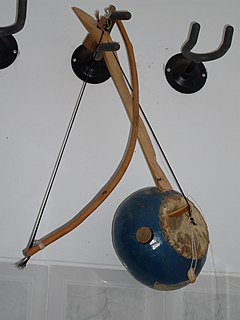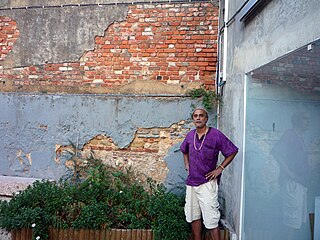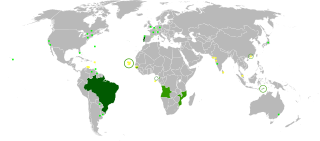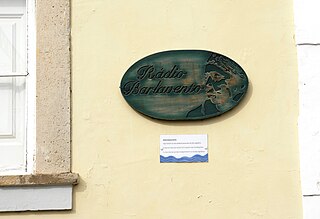
Mindelo is a port city in the northern part of the island of São Vicente in Cape Verde. Mindelo is also the seat of the parish of Nossa Senhora da Luz, and the municipality of São Vicente. The city is home to 93% of the entire island's population. Mindelo is known for its colourful and animated carnival celebrations, with roots in Portuguese traditions.

Cape Verde is known internationally for morna, a form of folk music usually sung in the Cape Verdean Creole, accompanied by clarinet, violin, guitar and cavaquinho. Funaná, Coladeira, Batuque and Cabo love are other musical forms.
Jornal Horizonte or O Horizonte is a weekly Cape Verdean newspaper that covers the top stories in the archipelago and local stories from each island. Expresso das Ilhas is located in the Cape Verdean capital city of Praia and is one of the most circulated newspapers and dailies in Cape Verde..

Arménio Adroaldo Vieira e Silva is a Cape Verdean writer, poet and journalist. He began his activity during the 1960s, collaborated in SELÓ, Boletim de Cabo Verde, Vértice (Coimbra) review, Raízes, Ponto & Vírgula, Fragmentos, Sopinha de Alfabeto and others.

The cimboa, also known as the cimbó[sĩˈbɔ], is a musical instrument from Cape Verde. It is a bowed chordophone that was traditionally used to be played with the batuque dances.
José Gabriel Lopes da Silva, also known as Gabriel Mariano, was a Cape Verdean poet, novelist, and an essayist.
Armando Zeferino Soares, was a Capeverdean composer, author of the famous song Sodade.
Belinda Lima Francis, on album cover simply Belinda, is a Cape Verdean-American singer based in Mindelo.

The history of the cinema of Cape Verde dates back to the arrival of film-makers in Mindelo in the early twentieth-century. The first picture house was established in Mindelo around 1922, called Eden Park.
Basketball is the second most popular sport in Cape Verde. The league are divided into eleven divisions, Santiago and Santo Antão has two zones since the early 2000s. The basketball association is a federation which is known as the Capeverdean Basketball Federation. The FCBB became was founded in 1986 and became affiliated to FIBA in 1988.

RecordTV Cabe Verde is a channel of RecordTV in Cape Verde. It is the first Brazilian based channel to have its own version in Cape Verde. The network was launched on 31 March 2007.

Fernando Hamilton Barbosa Elias, also known as Mito or Mito Elias is a Cape Verdean artist, plastic artist and a poet.
Elisângelo Ramos is a Cape Verdean journalist who has been at RTC since 1997. He belongs to the broadcasting, television and the press sectors. He is a reporter for RCV in the city of Praia and is a producer of cultural programs.
The Culture of the Island of São Vicente, Cape Verde is the second richest in the nation, with a range of customs and practices common in the islands,
The 2018 Cape Verdean Football Championship season is the 39th beginner level competition of the first-tier football in Cape Verde. Also it was another season that it was sponsored by a clothing company Tecnicil, it was also known as the 2018 Cape Verdean Tecnicil football season or the 2018 Tecnicil Football Championships. The championship was governed by the Cape Verdean Football Federation. The season began earlier started on 7 April 2018 and finished on 2 June.
Criod de São Cente is a 2011 album by Val and Roberto Xalino. The songs were written by Val Xalino's son Roberto. The album includes the new single "Praía de Baia", one of Cape Verde's greatest ballads, released on Val Xalino's first album Dança Dança T' Manchê in 1987. Some singles features both Val and Roberto Xalino. The album also features music by Val and Roberto Xalino, Djo d'Eloy, Manuel de Novas and Luis Silva. Four singles from the record were nominated in the 2011 Cabo Verde Music Awards











